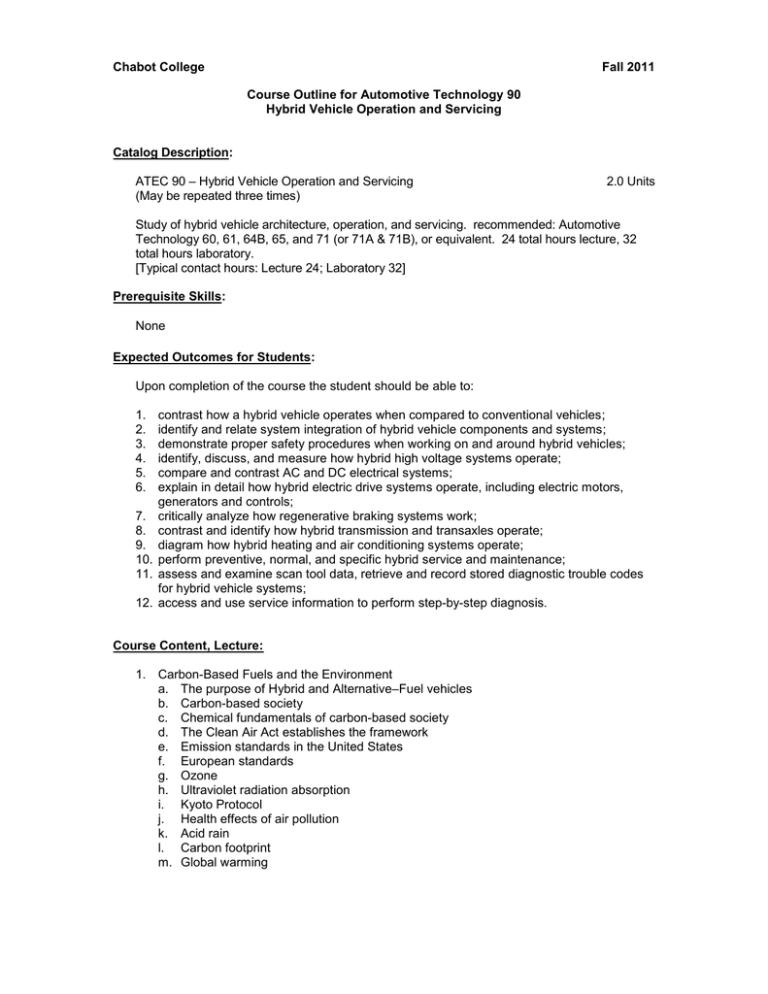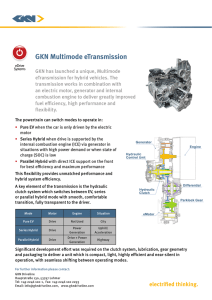Chabot College Fall 2011 Course Outline for Automotive Technology 90
advertisement

Chabot College Fall 2011 Course Outline for Automotive Technology 90 Hybrid Vehicle Operation and Servicing Catalog Description: ATEC 90 – Hybrid Vehicle Operation and Servicing (May be repeated three times) 2.0 Units Study of hybrid vehicle architecture, operation, and servicing. recommended: Automotive Technology 60, 61, 64B, 65, and 71 (or 71A & 71B), or equivalent. 24 total hours lecture, 32 total hours laboratory. [Typical contact hours: Lecture 24; Laboratory 32] Prerequisite Skills: None Expected Outcomes for Students: Upon completion of the course the student should be able to: 1. 2. 3. 4. 5. 6. 7. 8. 9. 10. 11. 12. contrast how a hybrid vehicle operates when compared to conventional vehicles; identify and relate system integration of hybrid vehicle components and systems; demonstrate proper safety procedures when working on and around hybrid vehicles; identify, discuss, and measure how hybrid high voltage systems operate; compare and contrast AC and DC electrical systems; explain in detail how hybrid electric drive systems operate, including electric motors, generators and controls; critically analyze how regenerative braking systems work; contrast and identify how hybrid transmission and transaxles operate; diagram how hybrid heating and air conditioning systems operate; perform preventive, normal, and specific hybrid service and maintenance; assess and examine scan tool data, retrieve and record stored diagnostic trouble codes for hybrid vehicle systems; access and use service information to perform step-by-step diagnosis. Course Content, Lecture: 1. Carbon-Based Fuels and the Environment a. The purpose of Hybrid and Alternative–Fuel vehicles b. Carbon-based society c. Chemical fundamentals of carbon-based society d. The Clean Air Act establishes the framework e. Emission standards in the United States f. European standards g. Ozone h. Ultraviolet radiation absorption i. Kyoto Protocol j. Health effects of air pollution k. Acid rain l. Carbon footprint m. Global warming Chabot College Course Outline for Automotive Technology 90, Page 2 Fall 2011 2. Introduction to Hybrid Vehicles & Safety and Service procedures a. Driving and owning a hybrid electric vehicle b. Classifications of hybrid electric vehicles c. Belt alternator starter systems d. Levels of hybrid vehicles 3. Hybrid Batteries and Battery Service a. Evolution of battery technology b. Lead-acid batteries c. Nickel-cadmium d. Nickel-metal hydride e. Lithium-ion f. Lithium-polymer g. Zinc-air h. Sodium-sulfur i. Sodium-metal-chloride j. Battery comparison k. Role if the auxiliary battery in the hybrid system l. Lead-acid technology m. Battery ratings n. Lead-acid battery safety precautions o. Lead-acid battery testing p. Valve regulated lead-acid q. Role of the HV battery in the hybrid system r. High-Voltage (HV) battery construction s. HV battery cooling t. HV battery service 4. Fuel Cells and Advanced Technologies a. Fuel cell technology b. PEM fuel cells c. Direct methanol fuel cells d. Fuel-Cell vehicle systems e. Fuel-Cell hybrid vehicles f. Hydrogen storage g. Hydraulic hybrid storage system h. Homoheneous charge compression ignition (HCCI) 5. Electric Motors, Generators, and Controls a. Fundamentals of magnetism b. Electromagnetism c. Electromagnetic induction d. Electric motors e. Brushless motors f. Motor control g. Capacitors in hybrid controllers h. Converters and inverters 6. Internal Combustion Engine Systems a. Hybrid Internal Combustion Engines (ICE) b. Engine fundamentals c. Atkinson cycle d. Engine specifications e. Torque, work, and power Chabot College Course Outline for Automotive Technology 90, Page 3 Fall 2011 f. g. h. i. j. k. l. m. n. o. p. q. r. s. t. Hybrid engine design features Hybrid engine lubrication system Engine oil Synthetic oil Oil change intervals Hybrid engine ignition system Oxygen sensors Wide-band oxygen sensor Fuel injection systems Mechanical returnless fuel system Gasoline direct injection Demand Delivery Systems (DDS) Electronic returnless fuel system Fuel injectors Electronic throttle control 7. Power Steering & Hybrid Vehicle Heating and Air Conditioning a. Electronic power steering b. Hybrid ice cooling systems c. Cooling system components d. Coolant heat storage systems (2004-2009 Prius) e. Cabin heating systems f. Hybrid electrical system cooling g. Hybrid air-conditioning systems h. A/C components 8. Regenerative Braking Systems & Hybrid Vehicle Transmissions and Transaxles a. Principles of regenerative braking b. Types of regenerative braking systems c. Battery charging during regeneration d. Regenerative braking system e. How the regenerative braking system works f. Deceleration rates g. Engine design changes related to regenerative braking h. Servicing regenerative braking systems Course Content, Laboratory: Laboratory content mirrors the subjects listed in “Course Content, Lecture” with the inclusion of skill based exercises. Examples: a. Demonstrate the proper methods to perform a glove check b. Access HV battery data with applicable scan tool(s) and interpret the data c. Collect the appropriate service information related to disabling the high voltage system Chabot College Course Outline for Automotive Technology 90, Page 4 Fall 2011 Methods of Presentation: 1. 2. 3. 4. 5. Lecture (utilization of multimedia) Demonstration Guest speakers Laboratory Field trips Assignments and Methods of Evaluating Student Progress: 1. Typical Assignments a. Read chapter on Hybrid Batteries and Battery Service b. Complete review quiz at the end of chapter c. Complete laboratory assignments using service information, lecture materials, and text d. Demonstrate use of a scanner to look at Hybrid PID’s along with battery service and testing 2. Methods of Evaluating Student Progress a. Class participation b. Performance on the laboratory projects c. Homework d. Quizzes e. Final examination f. Practical examination Textbook(s) (Typical): Hybrid and Alternative Fuel Vehicles, Second Edition, James D. Halderman & Tony Martin, Prentice Hall, 2011 Special Student Materials: 1. 2. 3. Safety glasses Shop/safety clothing Note book and pencils KWS091610 ATEC 90 course outline.doc






